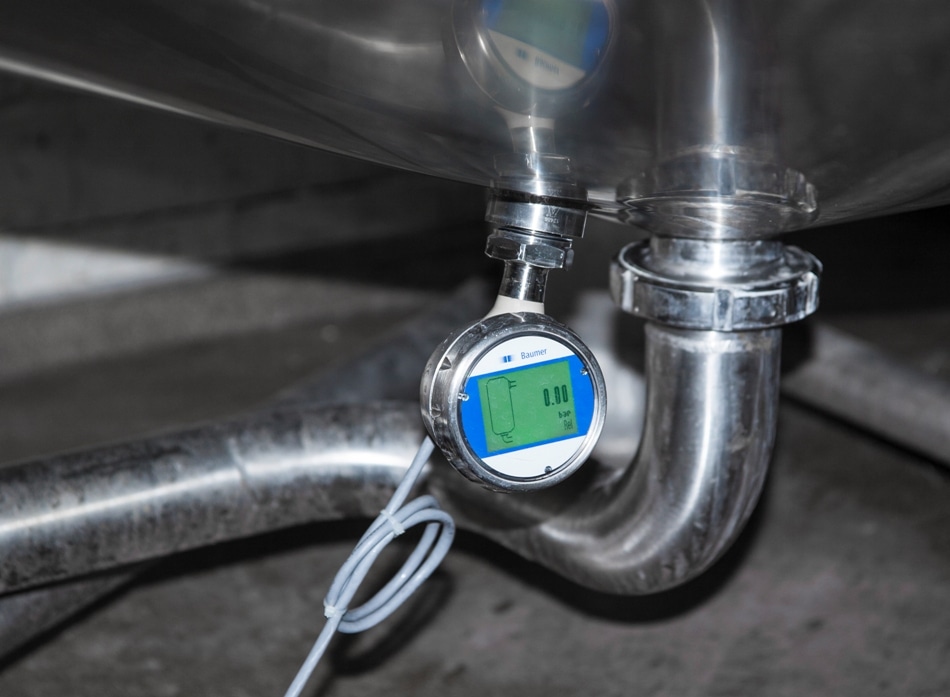Achieving process optimisation while controlling (cutting) costs is a constant challenge for all manufacturers, especially in the food manufacturing sector. For example, frequently varying recipes, a huge diversity of ingredients, different textures and specific filling levels places high demands on process systems, in some cases pushing conventional instruments and components to their limits.

A good example of this is at Homann, part of the Müller Group, manufacturers’ of a wide range of products including mayonnaise and salad dressings. Sensing and instrumentation specialists BAUMER have helped Homann in achieving their goal of maximising process optimisation in their production processes, thanks to the features and benefits of their CleverLevel, CombiPress and CombiLyz sensors.
Level Detection in Storage, Mixing and Buffer Tanks
Maintaining precise and reproducible switching of operations is vital to Homann, even in apparently simple tasks such as level detection. In storage tanks, conventional capacitive level switches, commonly known as ‘micro wave switches’, provide only limited reliability. Whilst they only require medium / specific configuration, outside these thresholds the low dielectric constant of some media like edible oil (DK Ɛ>10) can cause measuring errors if a film of lye has remained on the sensing tip after cleaning. For Homann, this was one of the considerations for choosing Baumer’s CleverLevel, the configurable universal level controller. Operating on frequency sweep technology, CleverLevel sensors are designed as a single sensor solution, reliably detecting the level of any media including liquids, solids and powders (fig 1).
Depending on the recipes and dielectric properties of the ingredients in mixing tanks, Homann previously used product combinations of capacitive limit switches and vibrating forks. However, depending on the media, response times ranged from very slow, to highly sensitive, resulting in impaired process efficiency.
Homann decided to replace their conventional solution with Baumer’s CleverLevel sensors, which provide extremely fast response times of 0.1 seconds. This has helped Homann to determine the optimum configuration which is conveniently changed and visualised via the FDT/DTM-based FlexProgram software (fig 2).
Once the mayonnaise, salad cream or dressing is fully emulsified and dispersed it is pumped into buffer tanks until it is added to the salad in a later production step. Here, medium specific viscosity and adhesion play an important role (fig 3). Conventional vibrating forks and capacitive limit switches were prone to measuring errors caused by adhering media, whereas CleverLevel is maintenance-free and not affected by media adhesion. Unpredictable downtime for system ventilation and pump changing are now things of the past. According to Frank Piatkowski, Application and Process Engineer at Homann,“CleverLevel is the one-sensor solution for different media and applications and since deploying CleverLevel, we have been experiencing a significant reduction in technical malfunctions”.
Measuring hydrostatic pressure in tanks of vinegar, edible oil and glucose
Homann’s Bottrop location uses a large outdoor vinegar tank and for consistent level monitoring they were looking for a precise, reliable, yet easy and convenient outdoor capable solution. Homann decided on Baumer’s CombiPress pressure transmitter. Thanks to 0.1% (MEW) accuracy and active temperature compensation, it provides unambiguous measured results, independent of media and ambient temperature. Easy configuration via the large touchscreen eliminates the need for an additional operating unit, while the robust housing with high IP67 rating reliably endures harsh outdoor conditions (fig.5).
Capable of detecting medium-specific density and filling levels, Homann also installed CombiPress in glucose containers and horizontal tanks of edible oil. Here CombiPress excels with its integrated linearization function and it also offers matching adaptors for optimum process connection. Frank Piatkowski added, “Whether indoors or outdoors, the CombiPress sensors contribute towards hassle-free automation and once installed, they are neither ’susceptible nor perceptible”.
Conductivity measurement in CIP processes
Every cycle in salad dressing or mayonnaise production requires CIP (Cleaning in Place). This reproducible process must precisely define detergent dosing, regardless of pressure and or temperature variations. At Homanns’ CIP installations in Bottrop, dosing needed to be improved and Baumer’s new CombiLyz conductivity sensor was the solution. Thanks to fast response time it ensures precise measured results at a maximum deviation of < 1%. The measuring connection of the inductive sensing element provides a 6.6 mm wide channel which will tolerate fabric or solid-containing media and this has helped Homann to optimize detergent dosing and reduce raw material costs. Frank Piatkowski confirmed, “Baumer products will be part of our considerations when we invest in new and state-of-the-art CIP installations. We appreciate that these innovative sensing solutions help us achieve our objectives of optimization, despite the complexities of our processes”.